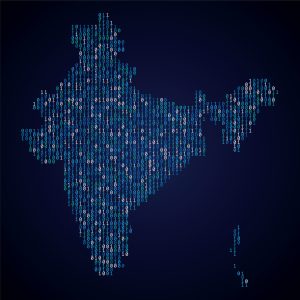While most discussions about artificial intelligence (AI) regulations focus on advanced economies, such as OECD countries, this series of articles systematically examines the AI regulation challenges in emerging economies of the Global South. In this piece, I explore India’s AI regulation dilemma, particularly the question of whether India should regulate AI now and, if so, what approach it should take.
India has been on a rapid path of economic development, poised to become a major player in the global tech supply chain. There are several key factors driving this trajectory. First, India’s high-tech labor force is experiencing rapid growth. Second, India’s economic potential is attracting increasing international investment. A recent report predicts that India will attract over $475 billion in foreign direct investment over the next five years.
Building upon the foundation of India’s talent pool and the influx of capital, the AI sector has experienced significant growth. AI technologies are making inroads into various industries in India, including healthcare, education, and public utilities.
The burgeoning AI sector reflects the Indian government’s ambition. India recognizes the pivotal role of AI and aspires to position itself as a “global AI hub.” India’s leadership in the Global Partnership on AI (GPAI) underscores these global aspirations. However, it is essential to assess India’s readiness, considering factors such as infrastructure, regulation, and public discourse.
India faces a dilemma in AI regulation. The Indian government itself has oscillated between a non-regulatory approach and a more cautious one, with an emphasis on mitigating user harm. In April of this year, the Indian government declared that it would not regulate AI to foster an innovation-friendly environment that could potentially propel India to global leadership in AI-related technologies. However, just two months later, the Ministry of Electronics and Information Technology signaled that India would regulate AI through the Digital India Act.
The argument against AI regulation is rooted in the pro-innovation stance, emphasizing the need to promote and adapt to the rapid advancement of AI technologies rather than restrain their development and integration into society through regulatory measures. As India’s Minister of Electronics and Information Technology Rajeev Chandrasekhar pointed out, “While AI is disruptive, there is minimal threat to jobs as of now. The current state of AI development is task-oriented; it cannot reason or use logic. Most jobs require reasoning and logic, which current AI cannot perform. AI might achieve this in the next few years, but not right now.”
Conversely, the arguments for AI regulation primarily center on the risks associated with AI, notably job displacement and other unintended consequences. A recent study from India’s Center for Policy Research highlights the importance of considering job losses due to AI, especially in a labor-intensive economy like India. Particularly concerning is the emergence of Embodied Artificial Intelligence, which could soon enable various types of robots to replace human labor, potentially leading to massive job losses.
When discussing the unintended consequences of AI, the potential misuse of data is one area of particular concern. Unlike the United States or the European Union, where strict data protection laws have been enforced, India lacked comprehensive data protection legislation until the introduction of the Digital Personal Data Protection Act 2023. However, the Digital Personal Data Protection Act has its immaturity and shortcomings, particularly when it comes to addressing emerging technologies like AI. Advocates are calling for stricter legislative safeguards to protect data, which is crucial for AI development.
In addition to the question of whether to regulate AI, another dilemma for India is how to regulate AI. Globally, there is a fragmented regulatory landscape, and within India, there are ongoing discussions about which existing regulatory framework India should model, whether India should follow the EU’s AI Act or evolving U.S. AI regulations. However, none of these seems to be an ideal fit for India.
Adopting existing approaches may not suit India for two reasons. First, the economic development stage of the EU and the U.S. differs from that of India. Consequently, India should prioritize identifying specific negative AI consequences and develop targeted regulations, rather than adopting an existing “comprehensive” law that may quickly become outdated.
Second, India’s cultural context is distinct from other regions in the world. Therefore, it is imperative to emphasize the significance of aligning AI regulations with India’s cultural identity and values. Indian legislators should draw from their own legal heritage and consider historical systems that prioritize morality and societal goals.
In conclusion, an analysis of India’s current AI regulation status reveals several key challenges. First, the Indian government has taken an oscillating stance on AI regulation. India’s approach to AI regulation has evolved from a lack of regulation to a more cautious one.
Second, India’s regulatory landscape for AI is fragmented, with various ministries and committees addressing different aspects. There is a need for a more centralized and cohesive approach.
Third, India’s approach to AI regulation must address data protection and privacy concerns. However, there has been an absence of data protection laws in India until recently.
Last but not least, India should consider its cultural identity and values when shaping AI regulations. This includes drawing from its historical legal systems that emphasize morality and societal goals.

































